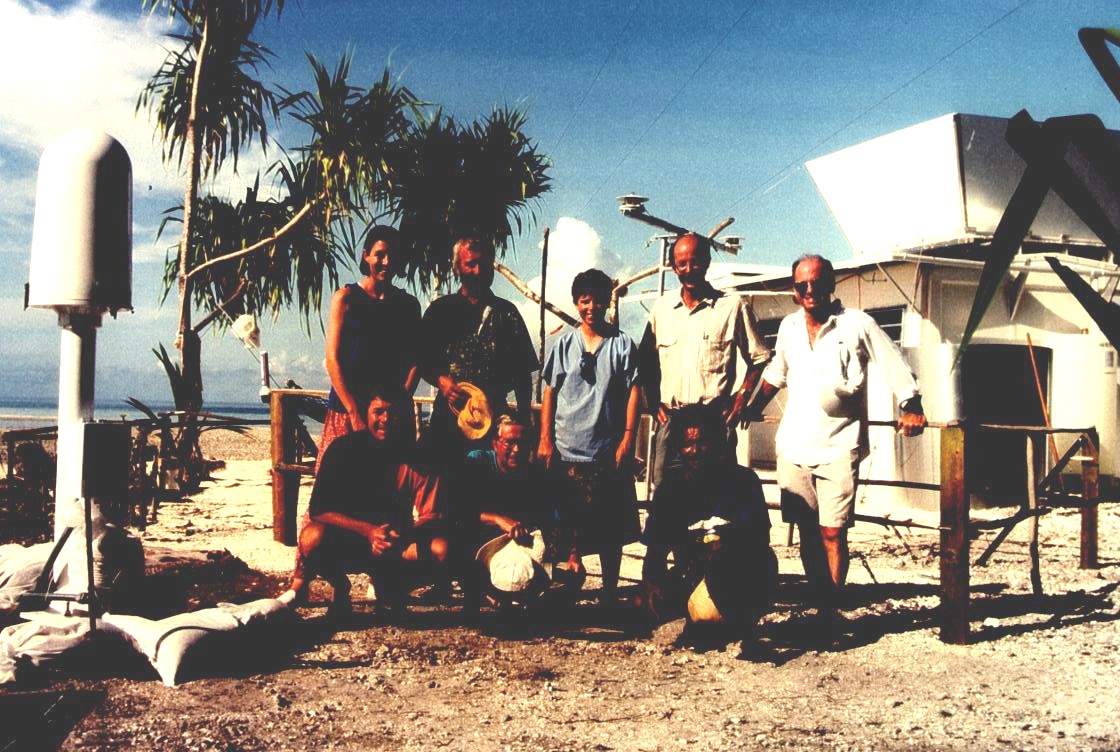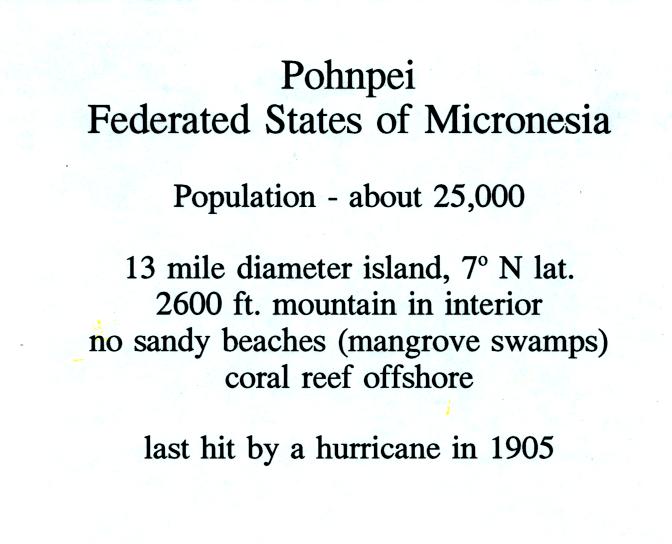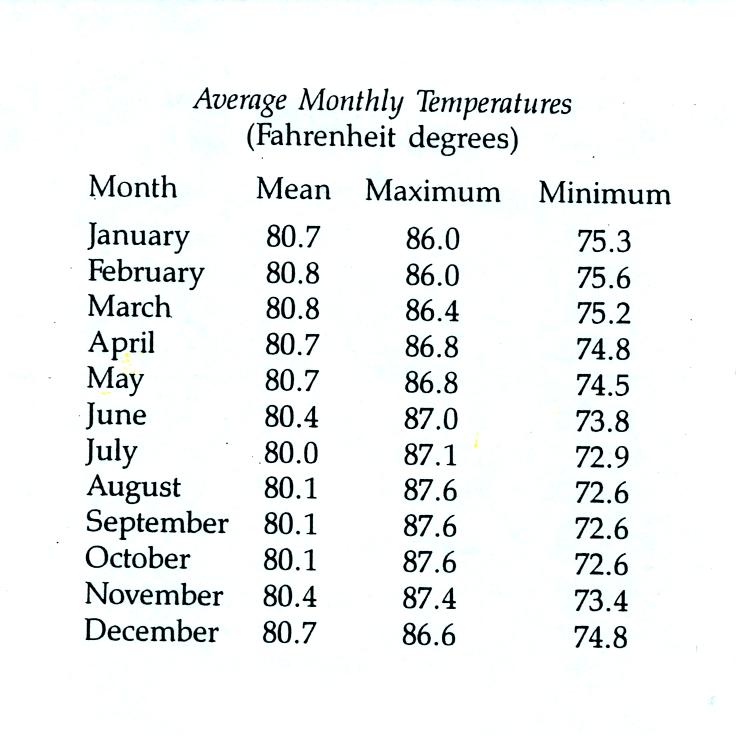Wednesday Oct. 8, 2008
click here to download today's notes in
more printer friendly Microsoft WORD format
Music today was "A Whiter Shade of
Pale" sung by Annie Lennox. Here also is the original version by
Procol Harum.
The Controls of
Temperature Optional Assignment is due today. If you haven't
done it by now it is too late. Here are the answers
to the questions on that assignment.
There's another Optional
Assignment due next Monday
The Quiz #2 Study Guide is done and
available online.
Class
began with a quick review of the two
rules governing the emission of EM radiation by objects.
An ordinary 200 W tungsten bulb connected to a dimmer switch can be
used to demonstrate these rules (see p. 66 in the photocopied
ClassNotes). We'll be seeing the EM radiation emitted by the bulb
filament.
The graph at the bottom of p. 66 has been split up into 3 parts and
redrawn for improved clarity.

We start with the bulb turned off (Setting 0). The
filament will be at room temperature which we will assume is around 300
K (remember that is a reasonable and easy to remember value for the
average temperature of the earth's surface). The bulb will be
emitting radiation, it's shown on the top graph above. The
radiation is very weak so we
can't
feel it. It is also long wavelength, far IR, radiation so we
can't see it. The wavelength of peak emission is 10 micrometers.
Next we use the dimmer switch to just barely turn the bulb on (the
temperature of the filament is now about 900 K).
The bulb wasn't very bright at all and had an orange color. This
is curve 1, the middle figure. Note the far left end of the
emission curve has
moved left of the 0.7 micrometer mark - into the visible portion of the
spectrum. That is what you are able to see, the small
fraction of
the radiation emitted by the bulb that is visible light (but just
long wavelength red and orange light). Most of the radiation
emitted by the bulb is to the right of the 0.7 micrometer mark and is
invisible IR radiation (it is strong enough now that you could feel it
if you put your hand next to the bulb).
Finally we turn on the bulb completely (it was a 200 Watt bulb so it
got
pretty bright). The filament temperature
is now about 3000K. The bulb is emitting a lot more visible
light, all the colors, though not all in equal amounts. The
mixture of the colors produces a warm
white light. It is warm because it is a mixture that contains a
lot more red, orange, and yellow than blue, green, and violet
light. It is interesting that most of the radiation emitted by
the bulb is still in the IR portion of the spectrum (lambda max is 1
micrometer). This is
invisible light. A tungsten bulb like this is not especially
efficient, at least not as a source of visible light.
You were able to use one of the diffraction gratings to separate the
white light produced by the bulb into its separate colors.
When you looked at the bright white bulb filament through one of the
diffraction gratings the colors were smeared out to the right and left
as shown below:
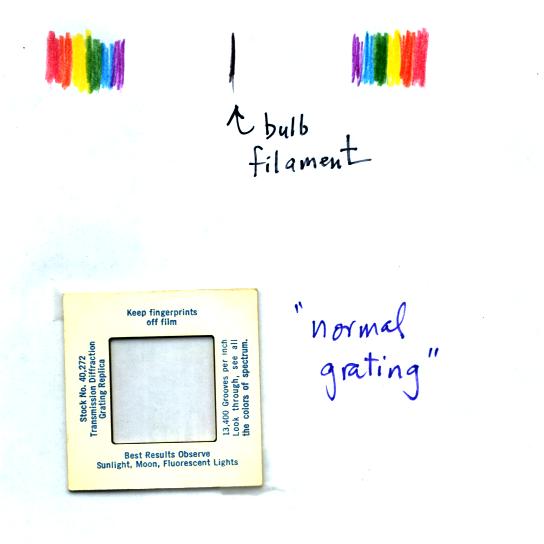
Some of the grating handed out in class behaved a little differently
and spread out the colors horizontally, vertically, and diagonally.
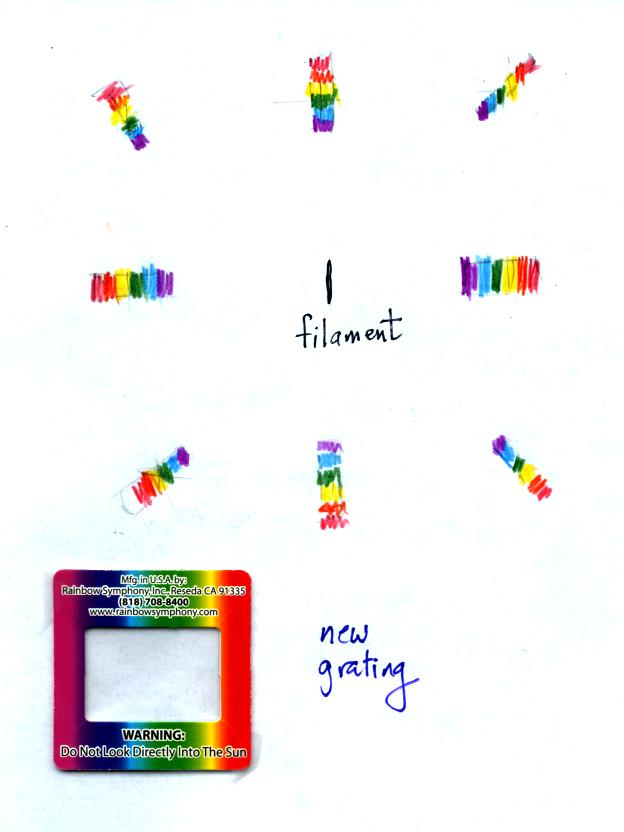
The sun
emits electromagnetic radiation. That shouldn't come as a surprise
since you can see it and feel it. The earth also emits
electromagnetic radiation. It is much weaker and invisible.
The kind and amount of EM radiation emitted by the earth and sun depend
on their respective temperatures.
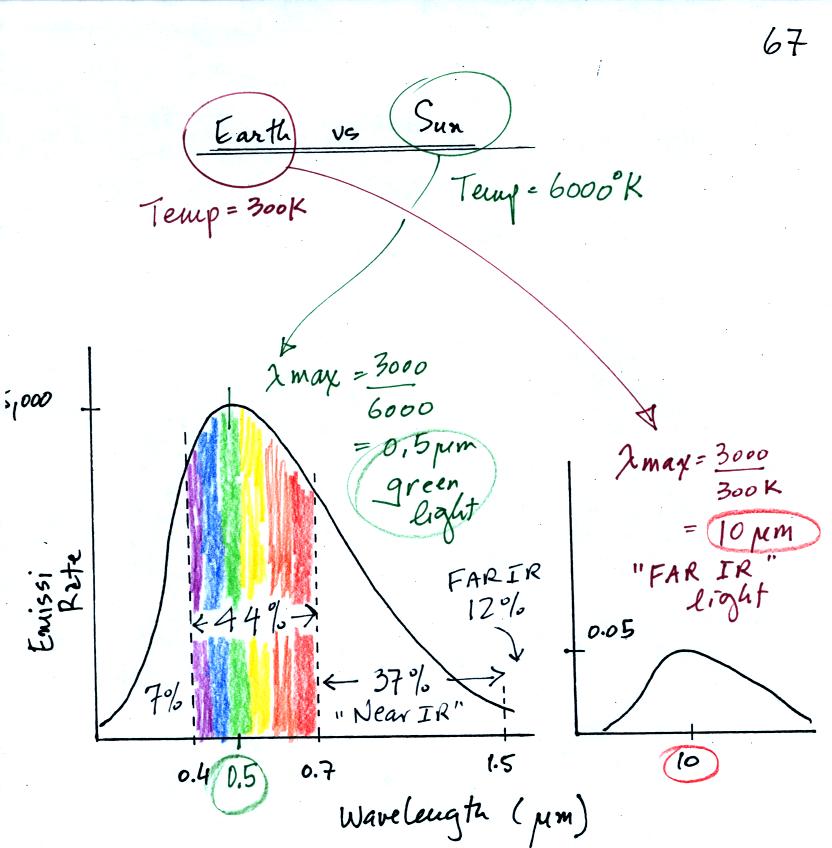
The curve on the left is for the sun. We first used Wien's
law and a temperature of 6000 K to calculate lambda max and got
0.5 micrometers. This is green light; the sun emits more green
light than any other kind of
light. The sun doesn't appear green because it is also emitting
lesser amounts of violet, blue, yellow, orange, and red - together this
mix of
colors appears white. 44% of the radiation emitted by the sun is
visible light, 49% is IR light (37% near IR + 12% far IR), and 7%
is ultraviolet light. More than half of the light emitted by the
sun is invisible.
100% of the light emitted by the earth (temperature = 300 K) is
invisible IR light. The
wavelength of peak emission for the earth is 10 micrometers.
Because the sun (surface of the
sun) is 20 times hotter than the earth a square foot of the sun's
surface emits energy at a rate that is 160,000 times higher than a
square foot on the
earth. Note
the vertical scale on the earth curve is different than on the sun
graph. If both the earth and sun were plotted with the same
vertical scale, the earth curve would be too small to be seen.
Now before moving on to the main event of the day (climate at a
point near the Equator in the middle of the Pacific Ocean) we quickly
reviewed some of the factors that cause seasonal changes in
climate. The two main factors are the angle of the sun in the sky
(how high is the sun above the horizon at noon), and the length of the
day. In the summer, the sun is high in the sky, the sunlight
reaching the ground is intense, and the incoming sunlight warms a
relatively small area on the ground. In the summer, there are
also more hours of daylight than in the winter. This is the main
reason why it gets so much hotter during the summer than in
winter. You should read
through the section Causes of
the Seasons on your own.
At the equator, the sun is always high in the sky (not always
overhead at noon, but always high in the sky). At the equator the
days are always 12 hours long. So the amount of incoming sunlight
energy stays relatively constant throughout the year at the
equator. You may remember that water moderates climate (it
doesn't get as hot in the summer and doesn't get as cold in the
winter). This is largely because of the high specific heat of
water.
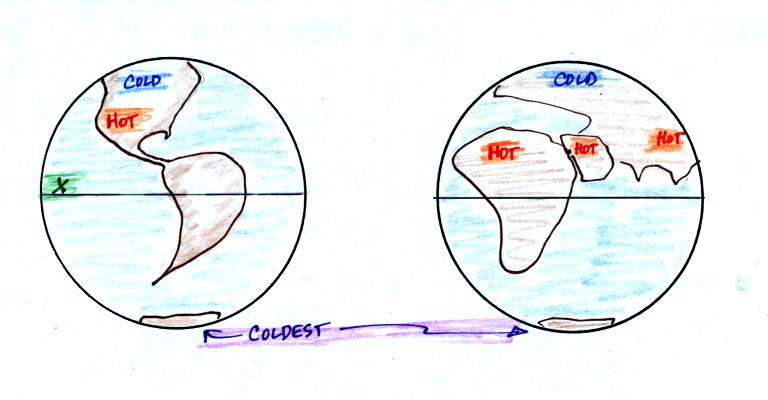
So the answer to the question "What is the climate like at Point X in
the figure above at left" is that the climate is warm and moist.
The most dramatic thing, however, is that there is essentially zero
seasonal change in climate. It is pretty much summer all year.
Asking about the climate at Point X was really just an excuse for me to
tell you about an amazing field experiment I took part in several years
ago.
The photograph above appeared on the cover of the April 1994 issue of
the Bulletin of the American Meteorological Society. If you look
closely you'll notice your NATS 101 instructor (he had been given the
nickname "Wilbur" by one of the members of the group, the other bald
man's name was Orville). This photo was taken on Kapingamarangi
Atoll (shown on the map below), shortly before all the men were about
to board ship and leave Kapingamarangi. The two women (Erica at
left, Maureen in the middle) were going to remain behind and operate
all of the research equipment. The scene looks happy enough, but
"Wilbur" revealed that he had fallen in love with one of the two women
and was anything but happy.
What we were doing on Kapingamarangi? We were a small
part of a much larger field experiment. Wilbur and Orville's job
was to install the tall white lightning detector at the left edge of
the photograph. They would later travel to Rabaul (on New Britain
island) and Kavieng (New Ireland island) in Papua New Guinea and
install
two more detectors. Papua New Guinea would turn out to be a very
different place. Until recently some of the highland tribes there
practiced cannibalism. Malaria is also endemic in Papua New
Guinea.
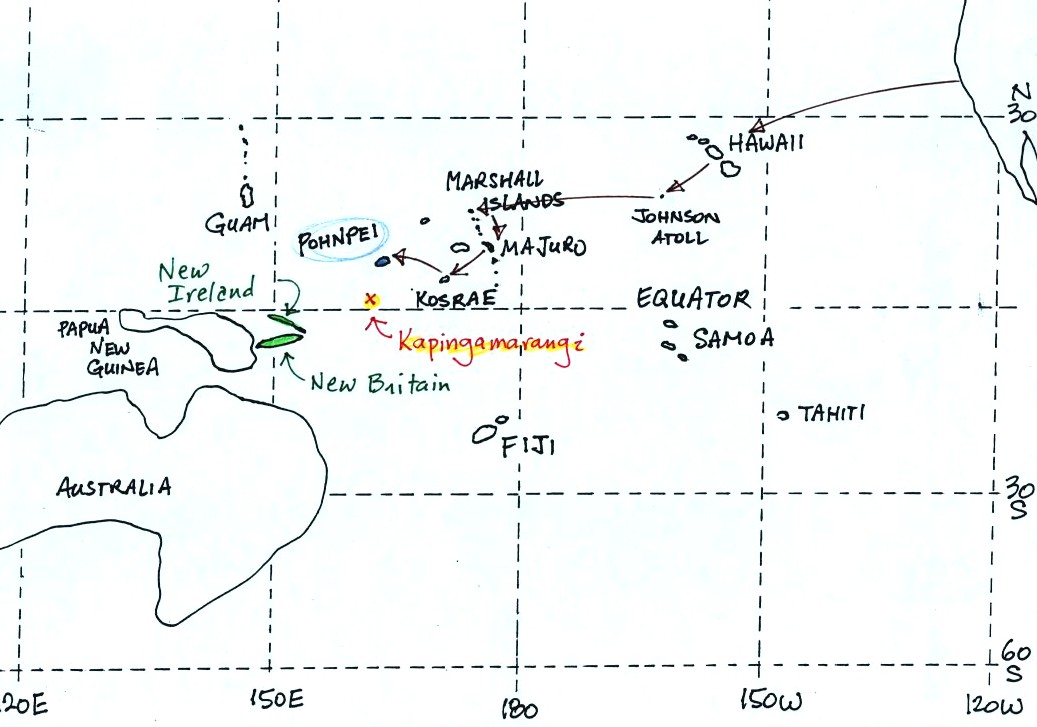
To get to Kapingamarangi you first need to fly to Pohnpei (an island in
the Federated States of Micronesia). The route is shown
above. Then you take a cargo ship for the 4 day sail to
Kapingamarangi. We had intended to fly to Pohnpei, set sail for
Kapinga the next day, and then spend about a month on
Kapingamarangi. The ship however was delayed 3 weeks. That
gave us plenty of time to visit the island of Pohnpei but ultimately
meant we could only spend a few days on Kapingamarangi..
Pohnpei is a fairly large island and, together with some of the
other Micronesian islands, is a popular, world-class, snorkeling and
scuba
diving destination. Pohnpei also has a weather station that
is
operated by the US National Atmospheric and Oceanic Administration
(NOAA).
Because of its low latitude and
the fact that it is surrounded by water you would expect a small annual
range of temperature at Pohnpei. You can see in the
table above just how small the annual range is: the average monthly
temperatures in Pohnpei range from 80.8 F in February and March to 80.0
F in July. The annual range is less than 1 F. By
comparison, the annual
range in Tucson is about 34 F (52 F in December
and January to 86 F
in July).
The following precipitation data show that Pohnpei is one of the
rainiest locations on earth
Close to 400 inches of rain may fall in the interior of
Pohnpei. The rainiest location on earth is in Hawaii with about
460 inches of
rain per year.
Pigs played an important part in the story told in class. Pigs
are also an important part of daily life on Kapingamarangi and Pohnpei
(as well as the other islands in Micronesia)
The Micro Glory (shown below) sails back and forth between Pohnpei
and Kapingamarangi about once a month. The ship carries supplies
to the people on Kapingamarangi. They pay for the supplies with
pigs (the pigs are sold on Pohnpei). We shared deck space on the
Micro Glory on the trip back to Pohnpei with 20 to 30 pigs (they were
hoisted aboard in nets)
Most of the low deck in the photo above (under the hoists)
was occupied by pigs on the return trip.
We also had a chance to sample some of the local beverages.
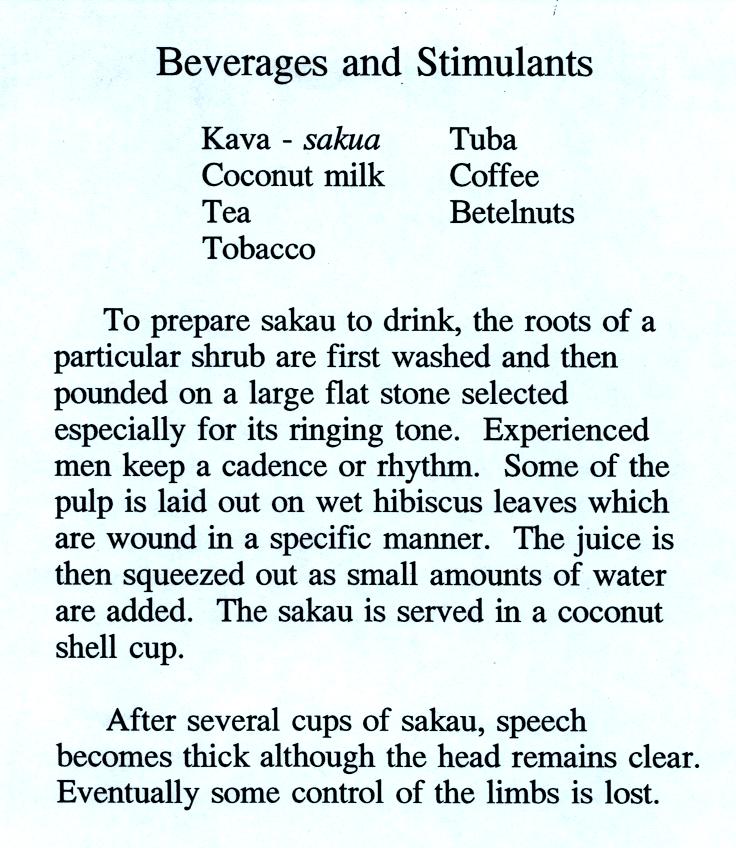
We never tried betelnut. Areca nuts are wrapped in betel leaves
and chewed together with lime (lime is pretty caustic, that is the
reason I didn't try betelnut). The resulting mixture is a mild
stimulant (some people add tobacco to the mix). The most
interesting aspect, however, is that chewing betelnut colors your mouth
bright red. You don't
swallow betelnut, you spit it out. You see the bright red stains
on sidewalks and the ground wherever you go. Most hotels will
also have a large sign near the entrance reminding guests not to chew
betelnut inside the hotel. You can read more about betelnut here.
Class ended with a proud display of my collection of carved wooden pigs
(remember they are a symbol of wealth). The pigs were purchased
in Rabaul, on New Britain island, in Papua New Guinea.







